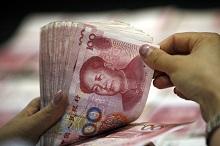
Typical street scene in Santa Ana, El Salvador. (Photo: iStock)
IMF Survey : Chinese Renminbi to Be Included in IMF’s Special Drawing Right Basket
December 1, 2015
- Renminbi becomes fifth currency making up SDR basket
- Inclusion is an important milestone in China’s global financial integration
- Decision reflects growing international use and trading of renminbi
The Chinese currency renminbi (RMB) is to be included in the basket of currencies which make up the IMF’s Special Drawing Right, or SDR.

Bank teller counting renminbi: The IMF’s Executive Board has determined the Chinese currency is “freely usable” (photo: Imaginechina/Corbis)
IMF SDR BASKET
This is the first time in over 15 years that the list of currencies comprising the SDR has been altered. The change was agreed by the IMF’s Executive Board following a regular review of the currencies which make up the SDR basket.
"The Executive Board's decision to include the RMB in the SDR basket is an important milestone in the integration of the Chinese economy into the global financial system. It is also a recognition of the progress that the Chinese authorities have made in the past years in reforming China’s monetary and financial systems,” said the IMF’s Managing Director, Christine Lagarde.
“The continuation and deepening of these efforts will bring about a more robust international monetary and financial system, which, in turn will support the growth and stability of China and the global economy,” she added.
SDR: an international reserve asset
The SDR is an international reserve asset created by the IMF in 1969 to supplement its member countries’ official reserves. Since 1999, when the euro replaced the Deutsche mark and French franc, its value has been based on a basket of four currencies: the U.S. dollar, the euro, the Japanese yen, and the British pound, that met the IMF’s inclusion criteria.
The composition and valuation of the SDR is typically reviewed every five years to ensure it reflects the relative importance of currencies in the global trading and financial systems.
The most recent review by the IMF’s Executive Board concluded that China and its currency met the two criteria for inclusion in the basket: that the issuing country is among the largest exporters in the world and that its currency is “freely usable.”
A currency is determined to be freely usable when it is widely used to make payments for international transactions and widely traded in the principal exchange markets. The IMF Executive Board’s determination that the RMB is freely usable and its decision to include the RMB in the SDR basket both take effect on October 1, 2016.
The review also acknowledged recent steps taken by the Chinese authorities to grant full access for official reserve managers and their agents to the onshore fixed-income and foreign exchange markets, as well as steps to enhance data disclosure.
SDR weights
The revised SDR basket will be based on the following weights: 41.73% for the U.S. dollar; 30.93% for the euro; 10.92% for the Chinese RMB; 8.33% for the Japanese yen, and 8.09% for the British pound. These weights are derived from a new formula adopted by the IMF in this review.
According to this new formula, the weights of the currencies in the SDR basket are based on the value of the issuers’ exports, the amount of reserves denominated in the respective currencies that were held by other monetary authorities, foreign exchange turnover, and international bank liabilities and international debt securities denominated in the respective currencies.
IMF reflecting shifts in global economy
The decision to include the RMB in the makeup of the SDR basket reflects major shifts in the global economy, and is a recognition of China’s progress over the last few decades in moving toward a more open and market-based economy.
The IMF staff’s report to the Executive Board notes that since the last SDR review in 2010, the use of the RMB in international payments has risen substantially. In addition, renminbi trading activity in foreign exchange markets covering two of the three major trading time zones has increased significantly, and can now accommodate transactions of the magnitude involved in IMF operations.
These developments could herald future opportunities for a more stable and resilient global financial system. “As China’s integration continues and further deepens, and is paralleled in other emerging market economies, it could bring about a more robust international monetary and financial system which, in turn, would support the growth and stability of the global economy,” said the IMF’s Director of the Strategy, Policy and Review Department, Siddharth Tiwari.
IMF operations and the RMB
“The RMB’s inclusion will also enhance the attractiveness of the SDR as an international reserve asset by diversifying the basket and making the SDR more representative of the world’s major currencies,” said Andrew Tweedie, Director of the IMF’s Finance Department.
As a freely usable currency, the RMB will play an important role in the Fund’s operations as, in practice, the bulk of the Fund’s lending activities takes place in freely usable currencies. The SDR interest rate, which forms the basis for the cost of borrowing from the IMF, will also include an RMB instrument starting in October.
Authorities of all currencies represented in the SDR basket, which now includes China, are expected to maintain a policy framework that facilitates operations for the IMF, its membership, and other SDR users in their currencies.







